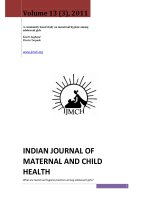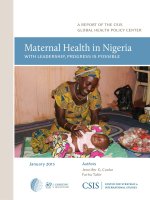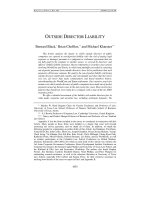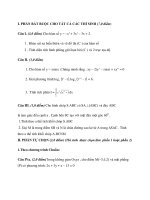RADIOLOGY potx
Bạn đang xem bản rút gọn của tài liệu. Xem và tải ngay bản đầy đủ của tài liệu tại đây (19.21 MB, 943 trang )
McGraw-Hill Specialty
Board Review
RADIOLOGY
Notice
Medicine is an ever-changing science. As new research and clinical experience broaden our knowledge, changes in
treatment and drug therapy are required. The authors and the publisher of this work have checked with sources believed
to be reliable in their efforts to provide information that is complete and generally in accord with the standards accepted
at the time of publication. However, in view of the possibility of human error or changes in medical sciences, nei-
ther the authors nor the publisher nor any other party who has been involved in the preparation or publication of this
work warrants that the information contained herein is in every respect accurate or complete, and they disclaim all
responsibility for any errors or omissions or for the results obtained from use of the information contained in this
work. Readers are encouraged to confirm the information contained herein with other sources. For example and in
particular, readers are advised to check the product information sheet included in the package of each drug they plan
to administer to be certain that the information contained in this work is accurate and that changes have not been made
in the recommended dose or in the contraindications for administration. This recommendation is of particular
importance in connection with new or infrequently used drugs.
Editor
Cheri L. Canon, MD
Professor of Radiology
Senior Vice Chair for Operations
Director, Division of Diagnostic Radiology
Chief, Gastrointestinal Radiology
University of Alabama at Birmingham
Birmingham, Alabama
New York Chicago San Francisco Lisbon London Madrid
Mexico City Milan New Delhi San Juan Seoul
Singapore Sydney Toronto
McGraw-Hill Specialty
Board Review
RADIOLOGY
Copyright © 2010 by The McGraw-Hill Companies, Inc. All rights reserved. Except as permitted under the United States Copyright Act of 1976, no part
of this publication may be reproduced or distributed in any form or by any means, or stored in a database or retrieval system, without the prior written
permission of the publisher.
ISBN: 978-0-07-160165-8
MHID: 0-07-160165-1
The material in this eBook also appears in the print version of this title: ISBN: 978-0-07-160164-1, MHID: 0-07-160164-3.
All trademarks are trademarks of their respective owners. Rather than put a trademark symbol after every occurrence of a trademarked name, we use names
in an editorial fashion only, and to the benefit of the trademark owner, with no intention of infringement of the trademark. Where such designations appear
in this book, they have been printed with initial caps.
McGraw-Hill eBooks are available at special quantity discounts to use as premiums and sales promotions, or for use in corporate training programs. To
contact a representative please e-mail us at
TERMS OF USE
This is a copyrighted work and The McGraw-Hill Companies, Inc. (“McGraw-Hill”) and its licensors reserve all rights in and to the work. Use of this work
is subject to these terms. Except as permitted under the Copyright Act of 1976 and the right to store and retrieve one copy of the work, you may not decom-
pile, disassemble, reverse engineer, reproduce, modify, create derivative works based upon, transmit, distribute, disseminate, sell, publish or sublicense the
work or any part of it without McGraw-Hill’s prior consent. You may use the work for your own noncommercial and personal use; any other use of the
work is strictly prohibited. Your right to use the work may be terminated if you fail to comply with these terms.
THE WORK IS PROVIDED “AS IS.” McGRAW-HILL AND ITS LICENSORS MAKE NO GUARANTEES OR WARRANTIES AS TO THE ACCURA-
CY, ADEQUACY OR COMPLETENESS OF OR RESULTS TO BE OBTAINED FROM USING THE WORK, INCLUDING ANY INFORMATION
THAT CAN BE ACCESSED THROUGH THE WORK VIA HYPERLINK OR OTHERWISE, AND EXPRESSLY DISCLAIM ANY WARRANTY,
EXPRESS OR IMPLIED, INCLUDING BUT NOT LIMITED TO IMPLIED WARRANTIES OF MERCHANTABILITY OR FITNESS FOR A
PARTICULAR PURPOSE. McGraw-Hill and its licensors do not warrant or guarantee that the functions contained in the work will meet your require-
ments or that its operation will be uninterrupted or error free. Neither McGraw-Hill nor its licensors shall be liable to you or anyone else for any
inaccuracy, error or omission, regardless of cause, in the work or for any damages resulting therefrom. McGraw-Hill has no responsibility for the content
of any information accessed through the work. Under no circumstances shall McGraw-Hill and/or its licensors be liable for any indirect, incidental,
special, punitive, consequential or similar damages that result from the use of or inability to use the work, even if any of them has been advised of the
possibility of such damages. This limitation of liability shall apply to any claim or cause whatsoever whether such claim or cause arises in contract, tort or
otherwise.
This book is dedicated to Malcolm, Olivia, and Evan, for their love
and endless patience,
and
To Heather, who is my balance between work and family,
and
To Bob Koehler for his wisdom, enthusiasm, and above all else, his friendship.
This page intentionally left blank
vii
Contributors xiii
Preface xix
Acknowledgments xxi
Section I
CENTRAL NERVOUS SYSTEM
1 Technical Aspects of CNS Imaging 1
Joseph C. Sullivan III
2 Brain and Spine Anatomy 4
Surjith Vattoth and Joseph C. Sullivan III
3 Developmental Disorders 16
Surjith Vattoth and Joseph C. Sullivan III
4 Cerebrovascular Anatomy 28
Asim K. Bag and Joseph C. Sullivan III
5 Stroke and Cerebrovascular Diseases of the Brain 37
Ahmed Kamel Abdel Aal and Joseph C. Sullivan III
6 Intracranial Aneurysms and Vascular Malformations 46
Ahmed Kamel Abdel Aal and Joseph C. Sullivan III
7 Head Trauma 53
Ahmed Kamel Abdel Aal and Joseph C. Sullivan III
8 Spine Trauma 59
Joseph C. Sullivan III
9 Central Nervous System Neoplasms 63
Asim K. Bag and Joseph C. Sullivan III
10 Intracranial Infections 77
Ahmed Kamel Abdel Aal and Joseph C. Sullivan III
11 Neurodegenerative and White Matter Diseases 87
Ritu Shah and Joseph C. Sullivan III
12 Sella and Parasellar Pathology 94
Joseph C. Sullivan III
CONTENTS
viii CONTENTS
13 Face and Neck Anatomy 99
Surjith Vattoth and Joseph C. Sullivan III
14 Head and Neck Pathology 114
Asim K. Bag and Joseph C. Sullivan III
15 Spinal Cord Pathology 133
Joseph C. Sullivan III
Section II
PULMONARY
16 Normal Anatomy and Variants 139
John C. Texada and Satinder P. Singh
17 Thoracic Imaging 149
John C. Texada and Satinder P. Singh
18 Congenital Thoracic Anomalies 159
John C. Texada and Satinder P. Singh
19 Airway Diseases 170
John C. Texada and Satinder P. Singh
20 Pulmonary Infection 181
John C. Texada and Satinder P. Singh
21 Noninfectious Inflammatory Diseases 192
John C. Texada and Satinder P. Singh
22 Interstitial Lung Disease 203
Ian Malcolm and Satinder P. Singh
23 Pulmonary Neoplasms 209
Jonathan W. Walter, Ian Malcolm, and Satinder P. Singh
24 Pneumoconioses 219
John C. Texada and Satinder P. Singh
25 Pulmonary Edema 226
John C. Texada and Satinder P. Singh
26 Pulmonary Arterial Hypertension 235
Ian Malcolm and Satinder P. Singh
27 Radiation-Induced Lung Changes 242
John C. Texada and Satinder P. Singh
28 Mediastinal Masses 245
Satinder P. Singh
29 Pleural Diseases 254
Satinder P. Singh
30 Atelectasis 266
Satinder P. Singh
31 Diaphragmatic Diseases 269
John C. Texada and Satinder P. Singh
32 Chest Trauma 273
Ian Malcolm and Satinder P. Singh
33 Drug-Induced Lung Toxicity 280
John C. Texada and Satinder P. Singh
CONTENTS ix
Section III
CARDIAC
34 Cardiac MRI Technique 289
Satinder P. Singh
35 Cyanotic Congenital Heart Disease 291
Satinder P. Singh
36 Acyanotic Congenital Heart Disease 299
Satinder P. Singh
37 Valvular Heart Disease 306
Satinder P. Singh
38 Ischemic Heart Disease 310
Satinder P. Singh
39 Cardiac and Pericardial Tumors 317
Satinder P. Singh
40 Pericardial Disease 321
Satinder P. Singh
41 Cardiomyopathy 325
Satinder P. Singh
42 Cardiac Surgeries 330
Satinder P. Singh
43 Aortic Diseases 334
Satinder P. Singh
Section IV
GASTROINTESTINAL TRACT
44 GI Tract Contrast and Technique 343
Cheri L. Canon
45 Esophagus 344
Cheri L. Canon and Sanjiv K. Bajaj
46 Stomach 353
Sanjiv K. Bajaj and Cheri L. Canon
47 Small Bowel 361
Sanjiv K. Bajaj and Cheri L. Canon
48 Colon and Rectum 369
Sanjiv K. Bajaj and Cheri L. Canon
49 Appendix 376
Camden L. Hebson and Cheri L. Canon
50 Imaging of the Liver 379
Allen B. Groves and Lincoln L. Berland
51 Biliary System 387
Desiree E. Morgan
52 Spleen 398
Andrew S. Ferrell, Katherine P. Lursen, and
Robert E. Koehler
x CONTENTS
53 Pancreas 405
Desiree E. Morgan
54 Peritoneal Cavity and Abdominal Wall 417
Bhavik N. Patel, Sanjiv K. Bajaj, and Cheri L. Canon
Section V
GENITOURINARY TRACT
55 Intravenous Contrast Agents and Reactions 429
Philip J. Kenney
56 Kidneys 441
Michelle M. McNamara and Mark E. Lockhart
57 Ureters 448
Heather L. Haddad and Mark E. Lockhart
58 Urinary Bladder 452
Heather L. Haddad and Mark E. Lockhart
59 Adrenal Glands 457
Mark E. Lockhart and Mark D. Little
60 Male Reproductive System 463
Therese M. Webe and Heather L. Haddad
61 Female Reproductive System 471
Heather L. Haddad and Therese M. Weber
Section VI
ULTRASOUND
62 Ultrasound Physics 483
Kenneth Hoyt and Franklin N. Tessler
63 Abdominal Ultrasound 493
Franklin N. Tessler
64 Female Pelvic Ultrasound 507
Arthur C. Fleischer and Robert S. Morrison III
65 Obstetrical Ultrasound 512
Rochelle F. Andreotti, Reagan R. Leverett, and
Libby L. Shadinger
66 Vascular Ultrasound 528
Mark E. Lockhart and Heather L. Haddad
67 Scrotum 532
Michelle L. Robbin and Victoria E. Kraft
68 Thyroid, Parathyroid, and Neck Ultrasound 540
Mark D. Little and Franklin N. Tessler
Section VII
MUSCULOSKELETAL SYSTEM
69 Musculoskeletal Anatomy and Basic Physiology 549
Andrew S. Ferrell and Matthew C. Larrison
CONTENTS xi
70 Musculoskeletal Trauma 555
Roderick F. Biosca Jr. and Matthew C. Larrison
71 Infection 564
James S. Spann Jr. and Robert Lopez-Ben
72 Bone Tumors and Tumorlike Conditions 572
Matthew C. Larrison and Gregory S. Elliott
73 Arthropathies 581
Mark Sultenfuss and Robert Lopez-Ben
74 Endocrine and Metabolic Bone Disease 587
Michael A. Bruno and Robert Lopez-Ben
75 Hematopoietic and Miscellaneous Musculoskeletal 593
Disorders
Bhavik N. Patel, Joshua P. Smith, Matthew C. Larrison,
and Gregory S. Elliott
Section VIII
BREAST RADIOLOGY
76 Breast Anatomy and Imaging Modalities 601
Heidi R. Umphrey, Cheryl R. Herman, and David E. Hogg
77 Breast Screening and Breast Imaging Reporting 607
and Database System (BI-RADS) Lexicon
Heidi R. Umphrey, Cheryl R. Herman, and David E. Hogg
78 Evaluation of Breast Masses 612
Heidi R. Umphrey, Cheryl R. Herman, and David E. Hogg
79 Evaluation of Breast Calcifications 620
Heidi R. Umphrey, Cheryl R. Herman, and David E. Hogg
80 The Surgically Altered Breast 623
Heidi R. Umphrey, Cheryl R. Herman, and David E. Hogg
Section IX
INTERVENTIONAL RADIOLOGY
81 Diagnostic Arteriography 627
Heidi R. Umphrey and Baljendra S. Kapoor
82 Arterial Interventions 640
Anne F. Fitzpatrick and Souheil Saddekni
83 Venous Disease 649
Karthikram Raghuram, Kay M. Hamrick, and
Jeffrey R. White
84 Abdomen and Liver 659
Kok C. Tan and Souheil Saddekni
85 Gastrointestinal and Biliary Disease and Intervention 666
Kay M. Hamrick and Emily R. Norman
86 Genitourinary 674
Rachel F. Oser
xii CONTENTS
87 Pulmonary Angiography and Intervention 682
Ahmed Kamel Abdel Aal and Bao T. Bui
88 Spine Intervention 691
Shyamsunder B. Sabat and Edgar S. Underwood
89 Principles of Tumor Ablation 697
Clinton R. Smith and Edgar S. Underwood
Section X
NUCLEAR RADIOLOGY
90 Radiation Safety, Instrumentation, and Quality Control 707
Jon A. Baldwin and Kok C. Tan
91 Skeletal Nuclear Medicine 721
Pradeep G. Bhambhvani
92 Pulmonary Scintigraphy 732
Pradeep G. Bhambhvani
93 Nuclear Medicine: Gastroenterology 739
Sibyll Goetze
94 Genitourinary Nuclear Medicine 749
Jon A. Baldwin
95 Central Nervous System Scintigraphy 759
Jon A. Baldwin
96 Nuclear Cardiology 767
Sibyll Goetze
97 Thyroid and Parathyroid Scintigraphy 778
Sibyll Goetze
98 Oncology 788
Pradeep G. Bhambhvani and Sibyll Goetze
99 Laboratory Nuclear Medicine and Molecular Imaging 799
Jon A. Baldwin
Section XI
PEDIATRIC RADIOLOGY
100 Pediatric Musculoskeletal System 811
Brenton D. Reading and Robert P. Nuttall
101 Pediatric Chest 822
Richard S. Martin and Christopher J. Guion
102 Pediatric Cardiovascular Disease 829
Eric J. Howell
103 Pediatric Gastrointestinal Tract 837
Martha M. Munden and Daniel W. Young
104 Pediatric Genitourinary Tract 849
Jeremy T. Royal and Stuart A. Royal
105 Pediatric Neuroimaging 859
Shyamsunder B. Sabat and Yoginder N. Vaid
Index 873
xiii
Ahmed Kamel Abdel Aal, MD, MSc
Clinical Instructor
Department of Radiology
Chief of Vascular and Interventional Radiology
University of Alabama at Birmingham, VA
Medical Center
Birmingham, Alabama
Rochelle F. Andreotti, MD
Associate Professor of Clinical Radiology
Assistant Professor of Obstetrics and
Gynecology
Department of Radiology and Radiological
Sciences
Vanderbilt University Medical Center
Nashville, Tennessee
Asim K. Bag, MD
Fellow
Department of Radiology
University of Alabama at Birmingham
Birmingham, Alabama
Sanjiv K. Bajaj, MD
Resident Physician
Mallinckrodt Institute of Radiology
St. Louis, Missouri
Jon A. Baldwin, DO, MBS
Assistant Professor of Radiology
Division of Nuclear Medicine
Program Director, Nuclear Medicine Residency
Program
University of Alabama at Birmingham
Birmingham, Alabama
Lincoln L. Berland, MD, FACR
Professor of Radiology
Vice-Chairman for Quality Assurance and
Patient Safety
Chief, Body CT and 3D Laboratory
University of Alabama at Birmingham
Birmingham, Alabama
Pradeep G. Bhambhvani, MD
Assistant Professor of Radiology
Division of Nuclear Medicine
University of Alabama at Birmingham
Birmingham, Alabama
Roderick F. Biosca Jr., MD
Resident
Department of Radiology
University of Alabama at Birmingham
Birmingham, Alabama
Michael A. Bruno, MS, MD
Associate Professor of Radiology & Medicine
Penn State University College of Medicine
Director of Quality Management Services
The Milton S. Hershey Medical Center
Hershey, Pennsylvania
Bao T. Bui, MD
Resident
Department of Radiology
University of Alabama at Birmingham
Birmingham, Alabama
CONTRIBUTORS
xiv CONTRIBUTORS
Cheri L. Canon, MD
Professor of Radiology
Senior Vice Chair for Operations
Director, Division of Diagnostic Radiology
Chief, GI Radiology
University of Alabama at Birmingham
Birmingham, Alabama
Gregory S. Elliott, MD
X-Ray Associates of Louisville
Louisville, Kentucky
Andrew S. Ferrell, MD
Resident
Department of Radiology
University of Alabama at Birmingham
Birmingham, Alabama
Anne F. Fitzpatrick, MD
Fellow
Vascular and Interventional
Department of Radiology
University of Alabama at Birmingham Hospital
Birmingham, Alabama
Arthur C. Fleischer, MD
Professor of Radiology and Radiological
Sciences
Professor, Department of Obstetrics and
Gynecology
Vanderbilt University Medical Center
Nashville, Tennessee
Sibyll Goetze, MD
Assistant Professor of Radiology
Division of Nuclear Medicine
University of Alabama at Birmingham
Birmingham, Alabama
Allen B. Groves, MD
Fellow
Abdominal Imaging
Department of Radiology
University of Alabama at Birmingham
Birmingham, Alabama
Christopher J. Guion, MD
Clinical Professor of Radiology and Pediatrics
University of Alabama at Birmingham
Children’s Health System of Alabama
Birmingham, Alabama
Heather L. Haddad, MD
Assistant Professor of Radiology
University of Alabama at Birmingham
Birmingham, Alabama
Kay M. Hamrick, MD
Associate Professor of Radiology
University of Alabama at Birmingham
Birmingham, Alabama
Camden L. Hebson, MD
Chief Resident
Department of Pediatrics
Emory University
Atlanta, Georgia
Cheryl R. Herman, MD
Assistant Professor of Radiology
Mallinckrodt Institute of Radiology at
Washington University
St. Louis, Missouri
David E. Hogg, MD
Assistant Professor of Radiology
Medical Director Outpatient Radiology
University of Alabama at Birmingham
Birmingham, Alabama
Eric J. Howell, MD
Clinical Assistant Professor of Radiology and
Pediatrics
University of Alabama at Birmingham
Children’s Health System of Alabama
Birmingham, Alabama
Kenneth Hoyt, PhD
Assistant Professor of Radiology
University of Alabama at Birmingham
Birmingham, Alabama
CONTRIBUTORS xv
Baljendra S. Kapoor, MD
Assistant Professor of Radiology
University of Alabama at Birmingham
Birmingham, Alabama
Philip J. Kenney, MD
Professor and Chair of Radiology
University of Arkansas for Medical Science
Little Rock, Arkansas
Robert E. Koehler, MD
Professor Emeritus of Radiology
University of Alabama School of Medicine
Birmingham, Alabama
Victoria E. Kraft
Undergraduate
University of Chicago
Chicago, Illinois
Matthew C. Larrison, MD
Assistant Professor of Radiology
Program Director, Musculoskeletal Fellowship
University of Alabama at Birmingham
Birmingham, Alabama
Reagan R. Leverett, MD
Instructor
Women’s Imaging Fellow
Department of Radiology
Vanderbilt University Medical Center
Nashville, Tennessee
Mark D. Little, MD
Clinical Instructor of Radiology
University of Alabama at Birmingham
Birmingham, Alabama
Mark E. Lockhart, MD, MPH
Associate Professor of Radiology
Chief, Genitourinary Radiology
Program Director, Abdominal Imaging
Fellowship
University of Alabama at Birmingham
Birmingham, Alabama
Robert Lopez-Ben, MD
Associate Professor of Radiology
University of Alabama at Birmingham
Birmingham, Alabama
Katherine P. Lursen, MD
Resident
Department of Radiology
University of Alabama at Birmingham
Birmingham, Alabama
Ian Malcolm, MD
Assistant Professor of Radiology
University of Alabama at Birmingham
Birmingham, Alabama
Richard S. Martin, MD
Clinical Assistant Professor of Radiology
and Pediatrics
University of Alabama at Birmingham
Children’s Health System of Alabama
Birmingham, Alabama
Michelle M. McNamara, MD
Assistant Professor of Radiology
University of Alabama at Birmingham
Birmingham, Alabama
Desiree E. Morgan, MD
Professor of Radiology
Vice Chair for Clinical Research
Chief, Body MRI
Medical Director, MRI
University of Alabama at Birmingham
Birmingham, Alabama
Robert S. Morrison III, MD, MS
Resident
Department of Radiology and Radiology
Sciences
Vanderbilt University Medical Center
Nashville, Tenessee
Martha M. Munden, MD
Associate Professor of Radiology and Pediatrics
University of Alabama at Birmingham
Children’s Health System of Alabama
Birmingham, Alabama
xvi CONTRIBUTORS
Emily R. Norman, MD
Resident
Department of Radiology
University of Alabama at Birmingham Hospital
Birmingham, Alabama
Robert P. Nuttall, MD, PhD
Clinical Assistant Professor of Radiology and
Pediatrics
University of Alabama at Birmingham
Children’s Health System of Alabama
Birmingham, Alabama
Rachel F. Oser, MD
Associate Professor of Radiology
Program Director, Vascular and Interventional
Radiology Fellowship
University of Alabama at Birmingham
Birmingham, Alabama
Bhavik N. Patel, MD
Resident
Department of Radiology
University of Alabama at Birmingham
Birmingham, Alabama
Karthikram Raghuram, DNB, MD
Assistant Professor
Section of Neuroradiology and Interventional
Neuroradiology
West Virginia University
Brenton D. Reading, MD
Resident
Department of Radiology
University of Alabama at Birmingham
Birmingham, Alabama
Michelle L. Robbin, MD, FACR
Professor of Radiology
Chief of Ultrasound
University of Alabama at Birmingham
Birmingham, Alabama
Jeremy T. Royal, MD
Resident
Department of Radiology
University of Alabama at Birmingham
Birmingham, Alabama
Stuart A. Royal, MS, MD, FACR
Clinical Professor and Chief of Radiology and
Pediatrics
University of Alabama at Birmingham
Radiologist-in-Chief, Pediatrics
Children’s Health System of Alabama
Birmingham, Alabama
Shyamsunder B. Sabat, MD
Fellow
Neuroradiology
Department of Radiology
University of Alabama at Birmingham
Birmingham, Alabama
Souheil Saddekni, MD, FSIR, FAHA
Professor of Radiology
Chief of Vascular and Interventional Radiology
Co-Medical Director, Heart and Vascular Center
University of Alabama at Birmingham
Birmingham, Alabama
Libby L. Shadinger, MD
Instructor
Diagnostic Radiology
Vanderbilt University Medical Center
Nashville, Tennessee
Ritu Shah, MD
Assistant Professor of Radiology
University of Alabama at Birmingham
Birmingham, Alabama
Satinder P. Singh, MD, FCCP
Associate Professor of Radiology
Chief Cardiopulmonary Radiology
Director, Cardiothoracic CT
University of Alabama at Birmingham
Birmingham, Alabama
Joshua P. Smith, MD
Resident
Department of Radiology
University of Alabama at Birmingham
Birmingham, Alabama
CONTRIBUTORS xvii
Clinton R. Smith, MD
Fellow
Vascular and Interventional Radiology
Department of Radiology
University of Alabama at Birmingham
Birmingham, Alabama
James S. Spann, MD
Resident
Department of Radiology
University of Alabama at Birmingham
Birmingham, Alabama
Joseph C. Sullivan III, MD
Assistant Professor of Neuroradiology
Residency Program Director
University of Alabama at Birmingham
Birmingham, Alabama
Mark Sultenfuss, MD
Resident
Department of Radiology
University of Alabama at Birmingham
Birmingham, Alabama
Kok C. Tan, MD, FRCR (UK)
Fellow
Interventional Radiology and Nuclear Medicine
Department of Radiology
University of Alabama at Birmingham
Birmingham, Alabama
Franklin N. Tessler, MD, CM
Professor of Radiology
Vice Chair for Radiology Informatics
Chief of Body Imaging
University of Alabama at Birmingham
Birmingham, Alabama
John C. Texada, MD
Fellow
Cardiothoracic
Department of Radiology
University of Alabama at Birmingham
Birmingham, Alabama
Heidi R. Umphrey, MD, MS
Assistant Professor of Radiology
University of Alabama at Birmingham
Birmingham, Alabama
Edgar S. Underwood, MD
Assistant Professor of Radiology
University of Alabama at Birmingham
Birmingham, Alabama
Yoginder N. Vaid, MBBS, DMRD, MD
Clinical Professor of Pediatrics and Diagnostic
Radiology
University of Alabama at Birmingham
Children’s Health System of Alabama
Birmingham, Alabama
Surjith Vattoth, MD, DMRD, DNB, FRCR
Fellow
Vascular and Interventional Radiology
Department of Radiology
University of Alabama at Birmingham
Birmingham, Alabama
Jonathan W. Walter, MD
Resident
Department of Radiology
University of Alabama at Birmingham
Birmingham, Alabama
Therese M. Weber, MD
Professor of Radiology
University of Alabama at Birmingham
Birmingham, Alabama
Jeffery R. White, MD
Resident
Department of Radiology
University of Alabama at Birmingham
Birmingham, Alabama
Daniel W. Young, MD, FACR
Clinical Professor of Radiology and Pediatrics
University of Alabama at Birmingham
Children’s Health System of Alabama
Birmingham, Alabama
This page intentionally left blank
xix
In recent years, there has been a paradigm shift in learning, specifically the
manner in which information is gathered and ingested. This is particularly no-
table in subject matter that covers great breadth or is rapidly evolving, such as
medicine, and more specifically, diagnostic imaging. Students and residents
(and for that matter, practicing radiologists) quickly turn to the Internet to
“Google™” unknown factoids, rapidly gathering information, in many cases
without source validation. This has created silo learning where tidbits of infor-
mation are immediately collected, answering the one specific question of con-
cern. However, there is little depth or longevity afforded with this learning
process, which in many cases does not drill down to the anatomic or patho-
physiologic fundamental principles. As a result, there is a lack of complete un-
derstanding, or even worse, misunderstanding, and the information is often
retained only long enough to address the question at hand.
This book is an attempt to address the silo learning afforded by the Internet.
It is organized according to 10 subspecialties and includes overviews of imag-
ing-based physics for ultrasound, MRI, and nuclear medicine. Content centers
on the fundamentals of anatomy and pathophysiology with concise relevant im-
aging correlation. This, however, is not a text emphasizing image interpretation,
as there are countless other references that do this quite well. At the end of each
chapter, the reader is challenged with a set of questions written in single best
answer, multiple-choice format. Detailed discussions of the answers enhance
and enforce the reader's learning experience.
The goal of this text is to provide a firm foundation for learning and refer-
ence during residency training, and through lifelong learning. Its intent is to
link together common concepts while presenting often complex material in a
simple, straight-forward manner, hopefully balanced with enough depth so that
fundamental concepts are reinforced so as to avoid piecemeal or silo learning.
PREFACE
This page intentionally left blank
xxi
I am indebted to the contributing authors for their knowledge, insight, and per-
severance. Their expertise has proven invaluable.
I would also like to thank Beth Parker, my assistant, for endless hours of ed-
iting and overall coordination of this project. Additionally, thanks goes to
Rachel Metcalf, Toni Braddy, Brittany Harris, and Pat Moore for their support
and to Tony Zagar for his illustrations. He has drawn clear, understandable fig-
ures despite my ambiguous and often conflicting instructions.
Finally, a note of appreciation goes to my fellow members of the Abdominal
Imaging Section at the University of Alabama at Birmingham, Department of
Radiology. Without your support and encouragement, this book would have
never happened. It is a real pleasure to work with you each and everyday.
ACKNOWLEDGMENTS
This page intentionally left blank
1 TECHNICAL ASPECTS OF
CNS IMAGING
Joseph C. Sullivan III
Imaging used to evaluate the brain, head and neck, and
spine primarily incorporates volume acquisition imag-
ing, mainly CT and MRI. Conventional radiography re-
mains useful in central nervous system (CNS) evaluation
primarily in the realm of prescreening for indwelling
metal foreign bodies and implants in patients undergoing
MRI and initial imaging in an emergency setting.
CT
CT uses an x-ray transmission algorithm to mathemati-
cally reconstruct a cross-sectional image of the body from
relative amounts of x-ray transmission. As the gantry of
the CT scans spins around the patient, a narrow beam of
x-rays is emitted to an associated row of rotating detec-
tors on the opposite side of the gantry. Relative transmis-
sion is calculated and a cross-sectional image is created
via computer algorithm. The use of multirow detectors
with CT has nearly eliminated conventional (nonhelical)
CT, as the speed at which helically acquired CT is now
obtained allows for increased areas of coverage without
breath-hold or with shorter breath-hold times. High-detail
three-dimensional imaging can be obtained via postpro-
cessing. Additionally, the larger number of detectors and
overlap of the spiral acquisition nearly eliminates misreg-
istration and volume-averaging artifacts.
The display of data with CT is a computer-based pixel
assignment relative to water densities, Hounsfield unit
(HU). This scale, named for Sir Godfrey Hounsfield as-
signs increasing HU to higher density materials with wa-
ter being O. Therefore, fat and air have negative HU and
bone is highly positive. Brain parenchyma and even CSF,
which is slightly more dense than water, have HU some-
where between that of water and bone.
The basis of the display of this data is relative to the
value given to each pixel and the display algorithm that is
chosen. The midlevel, or area of interest based on tissue
density, is the selected window level. A window width
encompassing this level increases or decreases the sur-
rounding variation of shades of gray displayed. There-
fore, to evaluate a specific portion of the anatomy, the
window is narrowed to a particular width to include the
desired surrounding tissues. Therefore, multiple different
window-width and window-level settings are used to
evaluate for parenchyma (approximately 35–40 HU),
blood (approximately 60–70 HU in a normal patient),
bone (2000 HU or greater). Dedicated narrow windows
are necessary to evaluate for stroke, specifically looking
for edema within the parenchyma (25–40 HU); “sub-
dural window” employs more of a soft-tissue window.
Image data can be reviewed in multiple ways and dif-
fering planes, allowing for increased information with-
out subjecting the patient to additional radiation. It
should be considered, however, that the imaging tech-
nique should be tailored for the specific clinical indica-
tion. Higher kVp provides improved resolution for more
dense material such as bone, versus increased mA to
give better resolution of soft tissue.
Ever-increasing multidetector helical acquisition and
appetite for improved anatomical resolution must be
balanced with risks of increased radiation dosage, par-
ticularly in those who are more susceptible to the ad-
verse effects of radiation, that is, infants and children.
CT images are obtained with x-rays and are therefore
subject to beam hardening and streak artifacts. As a
beam of photons passes through a particular section of
anatomy, it is attenuated so that the higher kVp photons
are transmitted and registered by the detector on the
contralateral side. This results in a misinterpretation by
the detector that there was higher transmission than ac-
tually occurred, in turn calculated by the computer as an
area of low density, thus lower HU. Streak artifact oc-
curs when there are edges of sharp density delineation
Section 1
CENTRAL NERVOUS SYSTEM
1
2 SECTION 1 • CENTRAL NERVOUS SYSTEM
between adjacent objects. As the computer sees the large
variation in x-ray attenuation, it misinterprets these re-
gions and produces a “star” or a multistreak artifact as the
gantry rotates around this interface. Motion artifact oc-
curs when structures change position within the field of
view as acquisition of the object changes position relative
to the gantry. As the gantry encircles the patient, this
causes a misregistration of the object in the field. This
may be secondary to normal physiological motion in the
case of heartbeat, respiration, vessel pulsation, or bowel
gas peristalsis. Although CT scanners have improved in
their speed of acquisition to the point this can be nulled or
even gated, patient motion remains a continuing problem.
MRI
MRI is a completely different form of volume acquisi-
tion. There are different tissue characteristics based on its
protons, resulting in differing T1 and T2 relaxation times.
The T1 relaxation time is the time it takes for a tissue to
become magnetized, while T2 indicates the time for loss
of this magnetization. These differing relaxation times are
localized within the field of the magnet depending on
small variations in the radiofrequency applied and re-
ceived by tailored antennas known as coils. Tissue within
a field of localization may not remain within that field or
may pass into that field under normal physiological con-
ditions. Specifically, blood flow may demonstrate a flow
void as blood flows through a blood vessel into and out of
a magnetized field. Also, in variation with CT, which is
acquired in a cross-sectional anatomic demographic
plane and reconstructed via postprocessing, MRI can be
acquired in multiple planes as the data is acquired volu-
metrically and presented in planes based on frequency en-
coding, corresponding to the x-axis, and phase coding, y-
axis. Respectively, slice location is determined by slight
variations and the gradient intensity along the z-axis.
MR is obtained in multiple varied sequence acquisi-
tions, the primary of which is a spin echo pulse sequence.
Standard T1- and T2-weighted images are created using a
short time of repetition and time of echo versus longer
times, respectively. Proton density sequences use a combi-
nation of long repetition time and short echo time, allow-
ing for accentuation of hydrogen density differences be-
tween tissues. Variations of spin echo, called multiple spin
echo, allow for the reduction of image acquisition time,
typically referred to as fast-spin or turbo-spin echo. The
trade-off is degradation of signal intensity and increased
fat intensity on T2-weighted imaging. Fat-suppression
techniques are often used to counter this effect and/or to
allow for detection of underlying fluid latent pathology.
Inversion recovery pulse sequences emphasize differences
between T1 relaxation times as a delayed time of inversion
is added to the time of repetition and time of echo; tissues
with short T1 relaxation times such as fat are suppressed
and tissues with an unexpected high water content (pathol-
ogy) are accentuated. Fat-suppression techniques attempt
to similarly depress the short T1 signal of fat; however,
these are highly sensitive to magnetic field inhomogeneity,
and do not work well with low field magnet strength. Fat
suppression is performed using a saturation pulse at a res-
onant frequency of fat applied to each imaging plane. Al-
though this is limited by its sensitivity for field inhomo-
geneity, this is better for use with postcontrast technique
than those of inversion recovery as the latter suppresses all
tissues with short T1 including those that may enhance af-
ter the administration of gadolinium. Echo planar imaging
incorporates fast MR techniques for multislice studies
with single radiofrequency excitation. It decreases motion
artifact and continues to show improvement in high-reso-
lution techniques such as blood perfusion and functional
MR. Gradient recall echo imaging pulse sequences em-
ploy multiple short flip angles of less than 90 degrees to
decrease the time taken to recover a signal. This, however,
creates sensitivity to imperfections in the magnetic field
from short T2 relaxation times, also known as T2 star.
Safety of the patient is the foremost concern. Ferro-
magnetic and magnetic susceptibility of implants, per-
sonal items carried by the patient, and support devices in-
advertently taken into the field of the magnet must all be
considered with each patient. Furthermore, although
some implants may not have ferromagnetic components,
the components of those implants should be carefully
evaluated as wires or loops in a magnetic field can gener-
ate electric current. Such radiofrequency current can
cause burns or false activation or failure of the implant.
The strength of the magnet must also be considered as
variations in magnetic field strength can have variable ef-
fects on all such devices. Some implants, although con-
sidered compatible with MR, may demonstrate artifacts
associated with disruption of the magnetic field. This im-
plies the object has some ferromagnetic quality. The
safety considerations and compatibility of implants far
exceeds the content of this text and should be considered
on an individual case-by-case basis.
Motion artifacts in MR are also more prevalent than
CT secondary to the longer acquisition time. Multiple
techniques such as shorter acquisition time and com-
puter reregistration are used for motion correction.
MYELOGRAPHY
Myelography is a useful tool in those who cannot be im-
aged adequately or safely with MRI. Although it is not
nearly as prevalent as it once was, indications for and
usefulness of myelography remain. A lumbar puncture is
performed and once a spinal needle is advanced into the
thecal sac, at a level that is deemed safe, the stylet is









